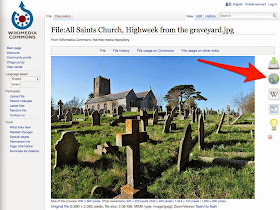 |
| By Smalljim (Own work) [CC BY-SA 3.0 (http://creativecommons.org/licenses/by-sa/3.0)], via Wikimedia Commons |
Under the current copyright law in the United States, every "work" (which includes a long list of publications and includes photos and images) is automatically protected by copyright. There is no requirement that any notice of copyright claim. A very complete explanation of U.S. Copyright law is online at Copyright.gov.
First, there is a difference between "permission" to use an image and being free of copyright. A copyright holder can give permission to use an image without giving up their copyright protection and ownership. On the web, there are several ways this can be done. The common way is to grant a limited license for the use of the image. There are several organizations that provide a venue for limited sharing of images online. Probably the most used of these organizations is the CreativeCommons.org. There are more than 882 million Creative Commons licensed works on the web. Here is a quote from their website about what they do:
What is Creative Commons?
Creative Commons is a nonprofit organization that enables the sharing and use of creativity and knowledge through free legal tools.
Our free, easy-to-use copyright licensesprovide a simple, standardized way to give the public permission to share and use your creative work — on conditions of your choice. CC licenses let you easily change your copyright terms from the default of “all rights reserved” to “some rights reserved.”
Creative Commons licenses are not an alternative to copyright. They work alongside copyright and enable you to modify your copyright terms to best suit your needs.Let me show you how I got the image at the beginning of this post.
1. I used Google Images to find the image. I searched Google Images for an image of a graveyard and I clicked on the link that says "Search tools" in the menu bar on the page:
I then clicked on the selection that says, "Labeled for reuse." That gives me a rough indication of which of all the images are either in the public domain (not subject to copyright) or are in the Creative Commons and can be used with some restrictions.
2. I chose an image from all those that appeared and clicked on it to see its status. Here is what I saw:
To avoid dealing with licenses for all the other images, I blurred out the ones that I wasn't interested in.
3. Then I went to the "View Page" link to see if this image could be used in my blog post. Ideally, I would be looking for images that are labeled "Public Domain" so that I could use them freely in my posts, but in this case, the image was available under a Creative Commons license.
The limitations in this case were "attribution" and "share alike." The limitations have their own explanation of what they entail.
4. I decided to use the image and so I clicked on the icon for use on the web on the right-hand side of the image.
That selection gives me the information I need to attribute the image. Here is a screenshot of the selections:
I then copied the Attribution from the form and put it as a caption to the image I used at the beginning of this post.
If you were to re-copy the image without the caption, you would be violating the copyright of the owner of the image, unless the image was in the public domain. As you investigate the images, you will find references to other licenses and conditions of use.
I sometimes use my own images in my blog posts. I certainly use all my own images on my WalkingArizona.blogspot.com blog. All of my images are subject to copyright and have my copyright notice embedded in them as metadata.
If the image is in the public domain, then that will be noticed in on the image page. Here is an example of an image in the public domain:
Here is the caption and notice from Google:
Johnson, Helen Kendrik (Ed.) (?) - Johnson, Helen Kendrik (Ed.): “World’s Best Music”' (1900)[1]
Permission details
public domain, hence royalty-free stock image for all purposes and no usage credit requiredNow what about the screenshots? That is yet an unresolved issue. But a screenshot of a copyrighted image would still be covered by copyright law. Google views screenshots as an exercise of the "fair use" doctrine and so do I. See Wikipedia: Screenshot.






.jpg)
Very good explanation. Thanks for sharing! I've included this post, and the subsequent "Be careful!" post in my NoteWorthy Reads post for this week: http://jahcmft.blogspot.com/2015/05/noteworthy-reads-15.html
ReplyDelete